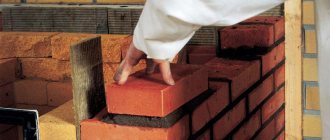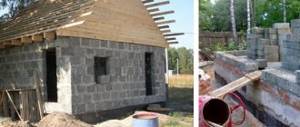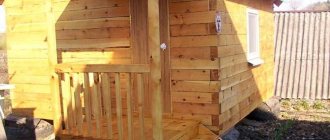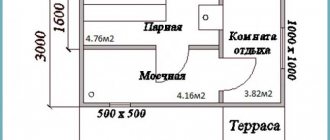Print 04/25/2020 — Stroika.ru
Attention! The construction portal Stroyka.ru is an all-Russian catalog of construction services and materials. Here you can find manufacturers and suppliers of products for removing efflorescence from bricks and other surfaces.
Brick has been and remains the most popular building material for buildings of any type. It is durable, reliable, a brick house will always be warm in winter and cool in summer. It would seem that this is an ideal solution for long periods of time and any budget. But brick can also bring surprises to the owners of houses and buildings. Especially in seasons such as autumn and spring. And the most unpleasant surprise is the appearance of efflorescence on the brick.
When a white coating appears on the wall of a building, the reasons for its appearance and how to deal with it - we will now deal with you.
What is the reason
Efflorescence on a brick is the appearance on the surface of a brick of a thin layer of various salts, which appears for several reasons. Most often this happens when the mortar for brickwork is prepared incorrectly - an excessive amount of water is added or a low-quality mixture is taken. In this case, water will evaporate in large quantities, leaving deposits in the form of salts on the surface. The chemical composition of water and laying bricks in the spring-autumn periods can also affect its appearance, because the abundance of humidity only enhances this process, and hard water, when evaporating, leaves all the microelements on the masonry.
Efflorescence is also a good indicator - if all the requirements were met during the construction process, then the reason lies in the dishonesty of the manufacturer himself. In fact, aesthetics fade into the background here - the main danger is that brick unprotected from salts begins to deteriorate faster and its service life is reduced significantly. There is a common misconception among many builders that before laying bricks, they need to be soaked, so that later, during the process of screeding the brickwork, the mortar will tighten evenly and the bricks will not crack.
Destruction of brick by salts over time Source kronotech.ru
This usually leads to the fact that immediately after drying, a white coating appears on the surface of the brick wall, which only intensifies over time. It is for this reason that quality control of work during the construction of brick buildings is important, which must take place at all stages. Traces of salt migration in hardened concrete mortar are also an excellent marker that the mortar was prepared without taking into account any building codes.
SNIP standards 03.03.01-87 in paragraphs 7.32 and 7.51 clearly regulate this issue: using a solution for facing work with a high content of chemical additives, modifiers and impurities is unacceptable, the alkali content in the solution should not exceed 0.6%, and the mobility of the solution should not be more than 4-6 cm. As for the thickness of the horizontal seam, according to the standards it ranges from 10 to 14 mm and should not go beyond these limits.
If high-quality brick is used (even if it is not simple red brick, but clinker), in acceptable weather conditions, then the problem of efflorescence lies only in the mortar and installation. To avoid the appearance of salts on the surface of the brickwork, you need to use a rigid mortar with an extremely low content of potassium and sodium oxides, or replace it with plasticized hydrophobic cement.
Traces of salts in mortar Source revkz.ru
The mortar should not get on the front side of the masonry, and any mortar that gets into it must be removed before it hardens. During rain, it is better to refrain from laying bricks, covering the brick with plastic film or other waterproof material, and sealing the horizontal seams with jointing before they harden.
In addition, you can also cover the facade with a protective compound or primer. Such measures will prevent the formation of salts due to the evaporation of water from the solution. In the case where salting appears on masonry that has already hardened for a long time, do not despair - the brickwork itself is not subject to destruction, the danger of salts threatens only the surface, which is subject to atmospheric influence and the formation of new salts, and solving this problem is not so difficult.
How to clean soot from cement
During the operation of a building with brickwork, soot may appear on it. You need to get rid of it as early as possible, otherwise it will be much more difficult to remove the soot later.
Before starting work you must:
- Cover the floor with film so that soot does not settle on it.
- Take detergent and tools for work.
- Clean the wall.
Any detergent (for example, powder) is suitable as a detergent. The main thing is that it foams well. A soap solution is diluted in a basin. After this, a sponge is dipped in soapy water and the cleaning of the brick begins.
You need to start from the top corner, then gradually move down. The surface should be slightly moistened and leave soap foam. After a few minutes, this foam along with the soot can be easily removed using a clean cloth.
After applying a soap solution with thick foam to the wall, you need to wait a while. If after a few minutes the foam turns black, then this product has begun to act and the solution can be washed off.
In addition to soap, you can use regular table vinegar. To do this, it is diluted in water in a 1:1 ratio. After this, the solution is applied to the wall, and after a few minutes the wall is cleaned with a wire brush.
There are special soot removers that are sold at any hardware store. They remove dirt more effectively and quickly, but this option is more expensive.
What can be done
First of all, don't panic. Simple rules will help to avoid salt deposits in the future: it is necessary to store the brick under a canopy, preferably in the shade, in no case allow it to be excessively moistened, use at least washed quarry sand if it is not possible to buy river sand, do not prepare too thin a solution and reduce the amount added modifying additives.
Proper storage of facing bricks will avoid salt deposits in the future Source kirpichrb.ru
See also: Catalog of companies that specialize in finishing materials and related work
To avoid unnecessary suspicions, it is better to play it safe and buy bricks only from those manufacturers who have been on the construction market for a long time and enjoy a certain reputation, even if it is a little more expensive - saving on bricks does not lead to anything good.
Secondly, you need to know how to remove efflorescence on brick that has already appeared. It is not enough to simply water the wall with a hose for the problem to solve itself. Many organizations are engaged in cleaning whitened facades and, for a certain budget, will return the building to its original appearance of beautiful red brick.
If you want to try to remove efflorescence on brick with your own hands, then there is room for experimentation - there are a huge number of brick and alcohol solutions on the market for removing salt on brick. They all have one thing in common: “a product for removing efflorescence on bricks” and any consultant at a construction supermarket or seller at the construction market will tell you which efflorescence agent is best to buy. But which one is really better to use will have to be selected by trial and experimentation, since the chemical composition of salts varies depending on the reason for their appearance.
Violation of the laying process Source stroy-podskazka.ru
It is also worth understanding that not only brick, but also concrete is susceptible to the formation of salts. If water penetrates from the inner layers of concrete into the outer layers or cracks occur, there is a high probability of white salt stains forming on the concrete surface. This happens due to the formation of free calcium oxide during the hydration of cement in the concrete solution, and the water present in the solution carries calcium oxide to the surface during evaporation.
This process will continue until a balance is reached between the solutions, and when the surface comes into contact with air, calcium carbonate will form, which is very difficult to remove. Such formations are removed using substances that can dissolve calcium salts, followed by mechanical action (for example, a brush). Compared to brick, cleaning concrete from efflorescence can be more of a hassle.
How to remove efflorescence on facing bricks? Of course, it is better to use a hard brush, but if these are not obvious salt crystals, but a light whitish coating, then a simple roller will do. After applying with a roller or brush, it is necessary to give the solution time for a chemical reaction, then rinse it all off with plenty of water, let the brick dry, and then be sure to treat it with protective agents against the formation of salts.
Formation of salts on concrete surfaces Source monolit-gr.ru
From paint
If the brick wall was painted, but began to peel off over time, then you need to urgently remove the old paint. The modern method of sandblasting walls is often used. But this may damage the material.
Therefore, it is best to adhere to the following recommendations:
- Perform initial paint removal.
- Get rid of fungus.
- Perform chemical treatment.
- Perform secondary paint removal.
First you need to remove the loose layer of paint. All visible wall surfaces on which peeling paint is visible are treated with a spatula. Then the wall is carefully brushed to remove dust.
The second stage is getting rid of the fungus. A special solution is prepared (bleach and water in a ratio of 3:1) and applied to the wall with a brush. After this, rinse thoroughly with water.
When the wall is completely dry, another solution is applied to it, which removes the remaining layer of paint chemically: caustic soda and water in a ratio of 1:3.
A small amount of flour is gradually added to this solution until it becomes mushy.
The prepared solution is applied to the wall with a spatula and left for 2 days. After this, warm water from a hose (under high pressure) removes the solution from the surface along with the old paint.
If you need to clean a wall in your house, then while applying the solution to the walls, strips of paper are glued to it. It is then removed from the surface along with the paint.
Instead of a homemade solution, you can purchase a special solution in the store. To breed it you need to follow the instructions.
How to prevent re-deposition of salts
When removing efflorescence from brickwork is completed, it is worth thinking about how to protect the wall from the reappearance of white spots. After treatment with special chemicals, the strength of the building material increases and becomes impermeable to precipitation, however, without a protective coating, these properties will not be preserved for a long time - you need to think about water-repellent impregnation.
On the modern building materials market there is a huge variety of means that allow you to protect the facade of a building from the effects of water, which will give the building a clean and well-groomed appearance for many years.
Brick protected from moisture always looks like new Source roomble.com
Advice from professionals
For high-quality cleaning of bricks, you can use the advice of professionals:
- When cleaning from cement mortar, the brick can be moistened with water. The cement will absorb a small amount of moisture and come off easily.
- The chemical method of cleaning bricks from mortar is carried out only for red ceramic bricks.
- When using various chemical solutions to clean brick, you need to wear gloves and protective clothing. It is advisable to cover the floor with film.
- Before cleaning brick, it is best to do a test cleaning on a small area. This will help ensure that the product will not damage the surface of the material.
Removing plaque from brick using improvised means is quite simple. To speed up the work, you can purchase the solution in the store. The main thing is to follow the instructions for carrying out the work. Due to this, you can get a high-quality result.
Briefly about the main thing
To make the wall look like new always, and not just in the first months after construction, you must:
- Comply with all technological requirements for choosing a brick and store it under a film to protect it from rain or snow;
- Prepare a solution with a minimum of additives, river (or washed quarry) sand and water purified from salts;
- Observe the climatic and weather conditions of construction, installation and drying;
- Promptly clean the facade from emerging stains and protect the brickwork with a water-repellent agent from exposure to water.
You need to understand the causes and consequences of the appearance of efflorescence, that this is not some kind of problem that appears randomly, but a harsh reality that needs to be dealt with not later, but to organize the construction process in such a way as to avoid the very causes of salt deposits. It depends only on you what the appearance of the brickwork will be.
Ratings 0
From plaster on brickwork
Quite often, brickwork is completely plastered. Over time, this finish loses its original appearance and there is an urgent need to update the walls in the room. An excellent option is to remove the old layer of plaster and renew the brickwork. This option will perfectly update the interior.
To properly remove plaster you need:
- Remove all furniture from the premises.
- Close all cracks tightly to prevent dust from entering other rooms.
- Prepare a hammer, chisel, brush.
- Remove the layer of plaster.
- Clean the wall from dust.
- Cover the surface with varnish.
Using a chisel and hammer, you need to remove the layer of plaster. You need to start from the top corner and gradually move down. The tool must be held at an angle.
During work, the plaster must be constantly removed from the room so that it does not accumulate underfoot and interfere with work. After upholstery, use a brush to remove all small particles and dust from the wall.
Then you need to wash the brick. Using a wet cloth, you need to clean the walls, starting from the top corner. To give brickwork a beautiful appearance, you can use a special varnish.
When do efflorescences form?
- In a fresh mixture (primary efflorescence). With a porous mixture, OH and Ca ions move outward with the help of residual moisture, where they combine with CO2 in humid air (deposits form on the surface).
- In the hardened mixture (secondary efflorescence). Water from precipitation, groundwater, and condensed moisture penetrates into the brickwork, thereby dissolving the salts of various chemical elements, including calcium. In warm, dry weather, the salt solution rushes to the surface of the masonry. The water evaporates, leaving salt crystals on the wall in the form of a white coating.
We invite you to familiarize yourself with: Wide extensions for interior doors
Traditional methods of removing efflorescence
Traditional methods of removing salt deposits from tiles or bricks have the following advantages:
- Cheap compared to traditional chemical agents;
- Easy to use;
- Safety for human health and the environment;
- No surfactants or allergens.
Such solutions include acetic acid, hydrochloric acid and ammonia. The use of acid solutions is justified by the fact that they quickly dissolve efflorescence, without giving them a chance to form again.
Sometimes owners of private houses try to remove efflorescence mechanically. This is ineffective, and the use of scrapers damages the tiles or bricks. In general, to apply any anti-efflorescence product, you must use a soft roller.
When working with acids and alkalis, it is imperative to use personal protective equipment. You should definitely wear protective gloves, even if the acid solution is only five percent. Acid can corrode hand skin, causing blisters and infections. You should never use an unknown acid.
However, some building materials can deteriorate from acid or ammonia; for example, their color may change or disappear altogether. Cement also suffers from acids and alkalis, which negatively affects the strength of the wall.











